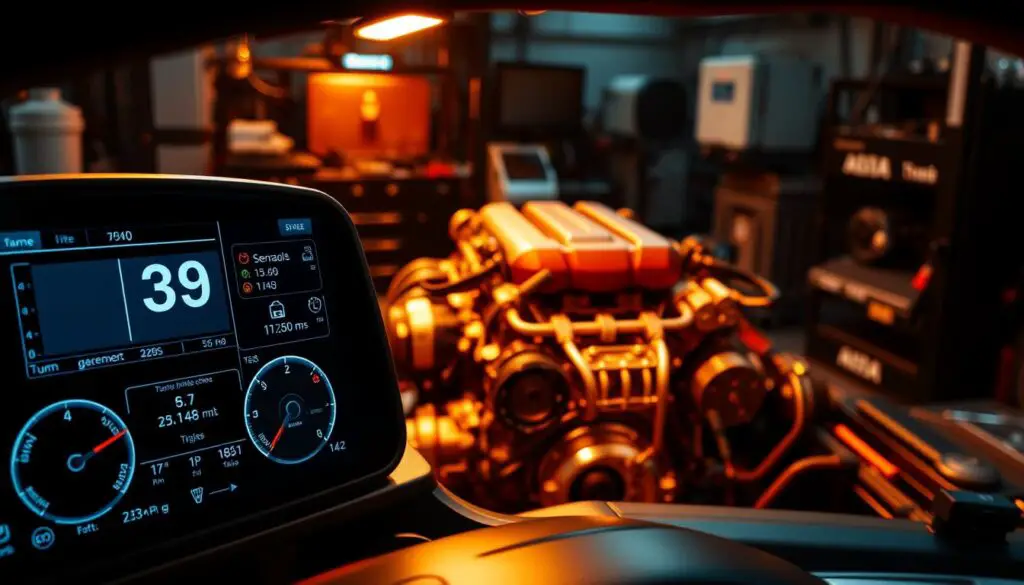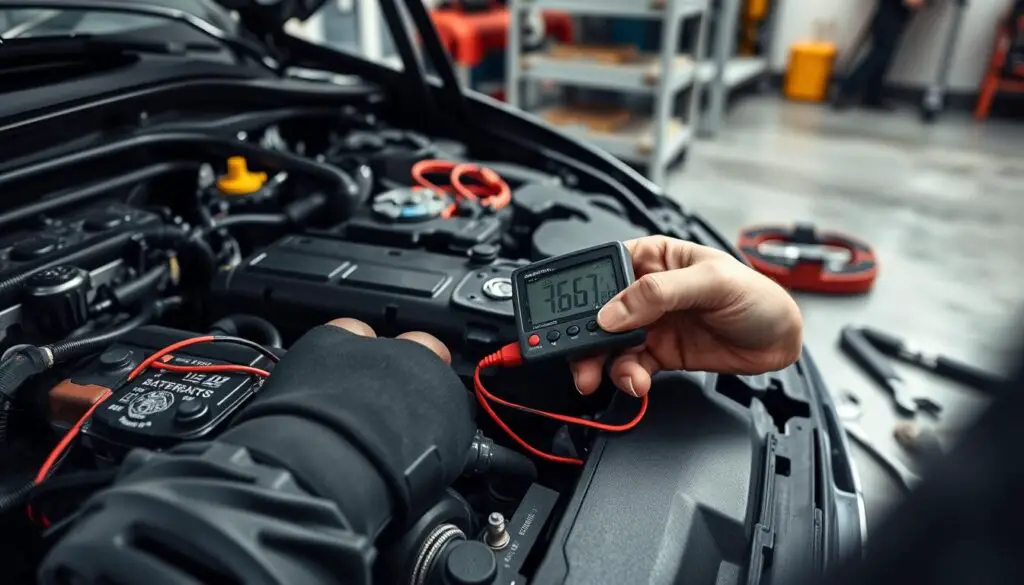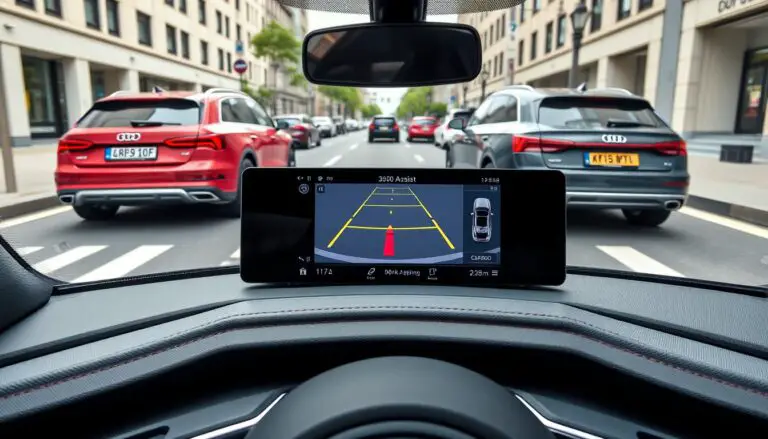If your car shows bright lights yet will not crank, this short guide helps you sort the most common reasons. A weak or failing battery can still run accessories while lacking the amps to turn the engine. Cold weather and many short trips speed battery wear.
Listen for clues: a single loud click with full dash lights often points to the starter or its solenoid. Rapid clicking or dimming lights usually mean the battery or a poor terminal connection needs attention.
Quick steps can save time and roadside hassle. Check that the car is in Park, clean battery terminals, test a spare key fob battery, or try a jump-start and then drive ~30 minutes to recharge. If basic checks fail, professional diagnostics will find deeper electrical faults.
Key Takeaways
- Bright lights do not guarantee a strong battery; check cranking ability.
- A single loud click usually signals starter issues, not the battery.
- Clean and tighten battery terminals before deeper testing.
- After a jump, drive about 30 minutes to help recharge the battery.
- Follow simple steps first, then move to systematic tests to avoid towing.
Understand the problem: why an Audi can have power but won’t start
Start by separating electrical symptoms from mechanical ones to narrow likely causes. A lit dash shows some voltage, yet the starting circuit needs far more amps to spin the engine. Low cranking current can hide under a healthy-looking battery.
If the battery and terminals test fine, an amperage draw test on the starter can reveal internal motor faults. A failing ignition switch may cut feed to the ECU or coils and create intermittent no-crank or crank-no-start events.

- Fuel delivery faults — clogged filter or weak pump — stop fuel rail pressure and cause crank-without-fire.
- Crank or cam sensor failures prevent the ECU from commanding spark or injectors.
- Immobilizer logic can leave accessories active while blocking starter engagement.
- Poor grounds or corroded cables raise resistance and stop proper cranking.
| Symptom | Quick check | Likely cause |
|---|---|---|
| Lights on, no crank | Measure starter draw | Worn starter or high resistance |
| Cranks, no fire | Verify fuel pressure & cam/crank signals | Fuel pump/filter or sensor fault |
| Intermittent starting | Test ignition switch & immobilizer | Switch fault or key recognition issue |
Understanding these layered reasons helps you pick the next test: battery and cables, starter draw, ignition outputs, or fuel and sensor diagnostics.
Quick checks first: safe, simple steps to try right now
Start with a quick safety check to make sure simple setup issues aren’t blocking a crank. Confirm the selector is in Park or Neutral, press the brake, and note any dash warnings before you proceed.

Safety and setup: Ensure the car is stable and the steering lock is free. If the key won’t turn, wiggle the wheel while turning the key to free a jammed lock.
Essential tools: Keep a multimeter, OBD-II scanner, and quality jump leads on hand. Use a multimeter to check battery voltage at rest and during crank; a collapse below 10V suggests a dead battery or high resistance.
“Bright lights with a loud click point to starter or wiring faults; dimming lights usually mean the battery or terminals need attention.”
- Clean and tighten battery terminals and engine grounds to restore proper current flow.
- Try a safe jump-start; after you start engine, drive ~30 minutes and then charge battery with a proper charger.
- Replace the key fob battery if security lights flash, or hold the fob close to the ignition to aid recognition.
- Run an OBD-II scan to capture fault codes that guide next steps; note overdue items like a clogged fuel filter for future service.
| Quick issue | Immediate check | Likely fix |
|---|---|---|
| Key won’t turn | Wiggle wheel while turning key | Free steering lock |
| Bright lights, click | Inspect starter wiring | Starter or solenoid repair |
| Lights dim when cranking | Measure battery under load | Recharge or replace battery; clean terminals |
Diagnose systematically: battery, starter, ignition, fuel, or security
Begin diagnostics by matching what the dash shows to how the engine behaves when you crank. This quick comparison steers you toward the right test without guessing.
Battery vs. starter clues: Bright, steady lights with a single heavy click usually point to a faulty starter or solenoid. Rapid clicking or dimming lights more often signal a weak battery or high-resistance connections.
Alternator and charging system
Verify the charging system; a failing alternator can leave the battery undercharged after stop-and-go driving. Test voltage at idle and while revving to confirm the alternator keeps the battery topped up.
Key fob and immobilizer behavior
If the security light flashes or the car ignores the fob, try a spare key fob or hold the fob near the start button/ignition. Replacing the fob battery often fixes weak recognition.
Scan for fault codes
Use an OBD-II scanner to read stored codes and live data. Watch crank and cam signals during crank; no RPM input suggests a sensor that will stop spark or fuel delivery.
“Document findings rather than guessing—correct diagnosis saves time and prevents unnecessary repairs.”
- Compare dash lights and crank behavior to isolate starter vs battery issues.
- Load-test the battery and measure voltage drop during crank.
- If battery/cables pass, perform an amperage draw test on the starter motor.
- Check ignition switch outputs and security system recognition before replacing costly parts.
| Symptom | Quick check | Likely cause |
|---|---|---|
| Bright lights, single click | Starter draw test | Bad starter or solenoid |
| Dimming lights, rapid click | Battery load test | Weak battery or corroded cable |
| No RPM signal during crank | Scan live data | Crank sensor or wiring fault |
Audi Won’t Start But Has Power? Zero in on starter and ignition switch
Zero in on the starter assembly and ignition circuit when the dash is lit but the engine will not crank. After you confirm the battery and terminals are good, targeted tests separate a bad starter from an ignition switch fault.
Starter motor and solenoid: clicks, draw, and cabling
Listen for a single heavy click with steady lights. That sound often signals the starter or solenoid, not the battery.
- Amperage draw testing: a high draw with no spin points to worn brushes or internal motor failure.
- Inspect starter cable condition for corrosion, frays, or heat damage that raises resistance and mimics battery issues.
- Use a voltage-drop test across the starter circuit during crank to localize the fault to the motor, relay, or cables.
- Watch for heat-related failures: some starters disengage after a run and return to function when cool.
Ignition switch faults: intermittent power to ECU and accessories
Symptoms of a failing ignition switch include difficulty turning the key, random loss of accessory power, and no-crank despite healthy voltage.
“No-crank with full lights or random stalling often traces back to the switch cutting power to the ECU or starter relay.”
Check switch outputs during crank and trace relay pathways with wiring diagrams to avoid swapping good parts for bad. Rule out the battery under load before condemning the starter; a borderline cell can hide as a motor problem.
| Symptom | Quick check | Likely cause |
|---|---|---|
| Single click, lights steady | Starter draw test | Worn starter motor or solenoid |
| No crank, accessories drop | Measure ignition switch outputs | Failing ignition switch |
| Intermittent after hot soak | Repeat test when warm | Heat-soaked starter or solenoid |
Fuel delivery issues that prevent engine starting
Check the fuel path next — many crank-no-starts trace back to blocked lines or a failed delivery component.
Fuel pump operation: prime sound, pressure testing, relays
On key‑on you should hear a brief prime from the fuel pump. No prime suggests checking relay, fuses, and pump power/ground.
Use a fuel pressure gauge at the rail to confirm correct pressure and volume. Document readings to avoid chasing ignition or sensor issues.
Clogged fuel filter: restricted flow and recommended intervals
A clogged fuel filter can restrict flow and cause hard starting. Many vehicles benefit from a filter change every 15,000–20,000 miles.
Injector and fuel quality problems: misfires, flooding, stale fuel
Test injector pulse with a noid light and inspect spray pattern when possible. Stuck or leaking injectors can flood cylinders.
Consider stale or contaminated fuel after long storage; draining and refilling with fresh fuel often fixes rough running.
“Confirm delivery before replacing expensive parts.”
- Listen for the pump prime at key-on; check relay and pump power if silent.
- Measure rail pressure to rule out starvation.
- Replace an overdue fuel filter to reduce pump load and clogged fuel symptoms.
- If flooding is suspected, use clear‑flood mode by fully depressing the throttle while cranking briefly, then idle to stabilize the engine.
- Verify the starter turns at normal speed; a weak battery can mimic fuel delivery issues.
| Symptom | Quick check | Likely cause |
|---|---|---|
| No prime at key-on | Listen, test relay and fuse | Failed pump or loss of power |
| Low rail pressure | Fuel pressure gauge | Clogged filter or weak pump |
| Cranks but floods | Noid light, clear‑flood | Leaking injector or stale fuel |
Engine management and mechanical causes
When cranking does not lead to combustion, inspect the engine management and mechanical timing before replacing parts at random.
Critical sensors and ECU: crank/cam signals, no-spark/no-fuel scenarios
Start by confirming the ECU sees engine RPM during crank. If scan data shows no crank pulse, a faulty crankshaft position sensor often blocks both spark and injector commands.
Compare cam and crank correlation in live data. If they are out of sync, the ECU will withhold ignition and fuel to protect the engine.
Check ECU power, grounds, and reference voltages to rule out module or wiring faults that mimic sensor failures. Validate fuel pressure alongside sensor signals so you do not miss clogged fuel or a failed fuel pump.
Timing and compression: belt/chain alignment and low compression
Measure compression on each cylinder. Low or uneven readings point to worn rings, valve timing errors, or other mechanical problems that electronics cannot fix.
Inspect timing components if scan data or compression tests suggest misalignment. A slipped belt or chain can prevent combustion and will also quickly damage valves on many engines.
“If the starter spins fast with no compression thump, suspect a broken timing component and stop cranking to avoid further damage.”
- Confirm ECU sees RPM during crank; no RPM often means a bad crank sensor.
- Compare cam/crank correlation; out-of-sync data points to timing belt or chain issues.
- Measure compression; low, uneven values indicate mechanical faults beyond the ignition or sensors.
- Verify starter speed and stop repeated cranks if timing failure is suspected to protect the vehicle.
| Symptom | Quick check | Likely cause |
|---|---|---|
| No crank signal on scan | Live data during crank | Crank sensor or wiring fault |
| No combustion despite crank | Compression test & cam/crank check | Timing belt/chain skip or low compression |
| Cranks but no spark/fuel | Verify ECU power and fuel pressure | ECU fault or clogged fuel filter/fuel pump |
What to do next: DIY fixes versus professional assistance
Start by matching the symptom to the safest next move: jump, charge, or call help. If lights dim severely and the engine will not crank, treat a dead battery as the primary issue. If lights stay bright and you hear a single heavy click, focus on the starter circuit instead.
When to jump-start, charge, or tow: choosing the right help today
Quick checks can save time on the road. After a safe jump-start, drive at least 30 minutes to help recharge, and then use a proper charger to restore capacity fully. Repeated failures mean schedule testing for alternator or battery faults.
- Dead battery: attempt a safe jump and then charge battery fully. If the battery dies again, book charging and load tests.
- Slow crank or no crank after jump: avoid repeated cranking; arrange a tow to prevent overheating starter cables.
- Strong click with bright lights: prioritize starter circuit testing. If lights fade or electronics reset, check battery and grounds first.
- Use roadside assistance when unprepared; a patrol can test battery/charging and advise whether you can drive to a shop safely.
- If the engine cranks but will not fire, run simple checks: listen for fuel pump prime or scan for codes. If unsure, book professional diagnostics.
- Document symptoms, battery age, fuel level, and warning lights to speed any repair.
“After a jump, drive to recharge and then use a charger to fully restore capacity.”
| Situation | Immediate action | Why |
|---|---|---|
| Dead battery, dim lights | Jump then charge | Restore voltage and confirm battery health |
| Single click, lights steady | Starter circuit test | Starter or solenoid likely |
| Cranks but no fire | Check fuel prime & scan codes | Fuel or ECU/sensor fault possible |
Local dealer support: For dealer-level assistance in Jacksonville, call 904‑565‑4000 for Audi Orange Park to arrange pickup/delivery within 20 miles for qualifying repairs over $300. That service can minimize downtime and get the vehicle into skilled care quickly.
Prevent future starting problems with smart maintenance
A short maintenance routine can stop most common starting failures before they happen. Regular checks keep the battery and charging system healthy and the engine ready to turn over when you need it.
Battery and charging care
Schedule a battery test at least once a year. Clean and tighten terminals to avoid voltage drop that causes car starting complaints.
Use a quality charger or maintainer for vehicles parked long-term. After a jump, drive about 30 minutes and then use a charger to fully recover capacity.
Ignition and fuel upkeep
Replace spark plugs and inspect coils on schedule to keep ignition strong. Weak ignition often shows as hard starts or misfires that stress the engine.
Change the fuel filter every 15,000–20,000 miles as a rule of thumb. Use quality fuel and add injector-safe cleaners if recommended to prevent deposits.
Security and key management
Keep a programmed spare fob and replace its battery proactively. Update vehicle software when available to reduce immobilizer-related starting problems.
Log maintenance dates and mileages in a simple guide to anticipate wear items before they cause sudden failures.
“Battery conditioners and proper fuel care cut the chance of a no-start after storage or seasonal downtime.”
| Area | Action | Why it matters |
|---|---|---|
| Battery | Annual test, clean terminals, use maintainer | Prevents voltage drop and extends service life |
| Ignition | Replace plugs, inspect coils | Improves starting and reduces engine stress |
| Fuel | Replace fuel filter at 15–20k mi, use quality fuel | Prevents restriction-related long crank and rough idle |
| Security | Keep spare fob, replace battery, update software | Avoids immobilizer locks and unexpected no-starts |
Conclusion
Close the loop by turning observations into action. Use your notes on lights, clicks, and cranking to pick the next safe test that will confirm the likely cause and get the engine start.
Common reasons for a no-crank with a lit dash include a weak battery under load, a failing starter motor, ignition switch faults, fuel delivery problems, or security/immobilizer blocks. Loud clicking with steady lights usually points to the starter; dimming lights point to the battery or poor connections.
When the steps above do not resolve the starting issues, confirm starter draw and voltage drop before replacing parts. Try a spare key or fresh fob battery if security recognition seems weak. After a jump, drive thirty minutes and then fully recharge the battery.
If you lack tools or safe space, seek assistance promptly to avoid repeated cranks that can worsen the problem and increase repair cost.
FAQ
What should I check first if my car has electrical power but won’t crank?
Verify basic safety: park in Neutral or Park, apply the brake, and note any dashboard warnings. Check battery terminals for tight, clean connections and look for a stuck steering lock. Replace a weak key fob battery and try a spare key. These simple steps often restore starting or reveal the next diagnostic move.
How can I tell if the battery or the starter is the problem?
Listen and watch when you turn the key. Rapid clicking or no crank with bright dash lights points toward the starter or its connections. Dim lights and slow crank indicate a weak battery. Use a multimeter to check battery voltage (12.4–12.7V at rest) and measure voltage while cranking—dropping below ~9.6V signals battery inability to deliver starter current.
Could the alternator cause a no-start even when there is power?
Yes. A faulty alternator may leave the battery with enough residual charge for accessories but not enough for repeated starts. Look for charging system warning lights, strange electrical behavior, or a battery that dies after driving. Test the alternator output with the engine running; it should be around 13.5–14.5V.
How does the immobilizer or key fob stop the engine from starting?
Modern security systems block ignition if they don’t recognize the transponder or fob. Symptoms include a crank without engine fire or immediate shutdown after a moment of cranking. Try a spare programmed key, reset by locking/unlocking with the fob, or scan for security-related fault codes. Professional reprogramming may be required.
What diagnostic tools are most useful at the roadside?
Carry a multimeter, OBD-II scanner with live data capability, and quality jump leads. A starter current clamp or basic amp meter helps pinpoint high-draw faults. These tools let you check battery voltage, read ECU codes, and confirm fuel pump and crank sensor signals quickly.
How do I check fuel delivery when the engine won’t start?
Listen for the fuel pump prime when you cycle the ignition—usually a short whirr from the tank. Use a fuel pressure gauge at the rail to confirm pressure within spec. A failed pump relay, blown fuse, clogged filter, or degraded fuel can stop starting even when electrical systems show power.
Can a clogged fuel filter prevent cranking or just rough running?
Severe restriction can prevent the engine from starting by starving injectors during cranking. More commonly, a dirty filter causes poor running and hesitation. Follow manufacturer intervals for filter replacement; consider swapping the filter if the vehicle has long service intervals or suspect contaminated fuel.
What starter motor signs indicate a failing solenoid or motor?
A single loud click when turning the key, but no crank, points to a bad solenoid or poor cable/connectors. Repeated rapid clicks suggest low voltage or a failing starter. Check starter cable condition, terminal corrosion, and measure starter draw—excessive amperage or no draw confirms starter or wiring failure.
Which sensors commonly cause a no-spark or no-fuel condition?
Crankshaft and camshaft position sensors are critical. If the ECU lacks their signals it will cut spark and fuel injector pulses. Other culprits include the crankshaft reluctor ring, wiring harness faults, and damaged connectors. An OBD-II scan showing P0335/P0340 or related codes helps narrow the fault.
How do timing or compression problems affect starting?
Incorrect valve timing from a slipped timing belt/chain or very low compression on one or more cylinders can prevent starting or produce violent cranking. Check for engine mechanical noises, missing cam synchronization codes, and perform a compression or leak-down test to confirm mechanical integrity.
When is jump-starting appropriate, and when should I call a tow?
Jump-start when the battery is the clear weak link and no major electrical faults exist. If the vehicle won’t crank after a successful jump, shows security faults, or emits grinding/clicking from the starter, stop and arrange a tow. Also tow if you suspect internal engine damage, timing failure, or a fault you cannot safely diagnose roadside.
What routine maintenance prevents most starting problems?
Regularly test and clean battery terminals, replace the battery at the end of its service life, and service the charging system. Replace spark plugs, ignition coils, fuel filters, and keep fuel fresh. Maintain spare programmed keys and keep immobilizer software updated during dealer service visits.
Should I attempt starter or ignition switch repairs myself?
Basic checks—cleaning terminals, testing voltage, or swapping a fob—are fine for DIYers with tools. Starter or ignition switch replacement often involves heavy components, underbody access, or security reprogramming and is best left to a qualified technician unless you have the right skillset and service manual.
How can scanning for fault codes speed up diagnosis?
An OBD-II scan reveals stored and pending codes that point to sensors, immobilizer events, fuel pump circuits, and ECU inputs. Reading live data like crank position, fuel pressure, and injector pulse can quickly separate electrical, fuel, or mechanical causes and prevent unnecessary parts replacement.
What immediate troubleshooting steps often restore a no-start with power?
Try a secure battery connection, use a known-good spare key, check fuses and relays for the starter and fuel pump, and listen for the fuel pump prime. If safe, perform a jump-start. If the car still won’t start, gather OBD-II codes and seek professional help to avoid repeated failed starts that can damage components.


